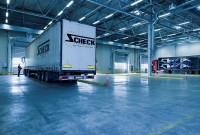- Home
- Business Processes
- Industry Knowledge
- Aerospace Industry
- Automotive Industry
- Banking Domain
- BFSI Industry
- Consumer/ FMCG Industry
- Chemicals Industry
- Engineering & Construction
- Energy Industry
- Education Domain
- Finance Domain
- Hospitality Domain
- Healthcare Industry
- Insurance Domain
- Retail Industry
- Travel and Tourism Domain
- Telecom Industry
- Leadership Skills
- eLearning
- Home
- Business Processes
- Order to Cash
- Miscellaneous Warehouse Processes
Miscellaneous Warehouse Processes
At the end of each inventory control, the Contractor provides the Ordering Person with an inventory report which contains a list of all stock adjustments. The Ordering Person uses the report to create, by use of his/her own means, necessary value and accounting adjustments related to the stock. Let us look at some to the mislaneous warehouse processes not covered earlier.
Let us look at some to the mislaneous warehouse processes not covered earlier.
- At the end of each inventory control, the Contractor provides the Ordering Person with an inventory report which contains a list of all stock adjustments. The Ordering Person uses the report to create, by use of his/her own means, necessary value and accounting adjustments related to the stock.
- Management of Source Documents (Sales orders, returns, transfer orders, production orders, and kanban)
- Location stocking limits
- Location volume Metrics
- Inventory Status
- Batch and serial item support
- Item receiving capabilities
- Multiple picking strategies
- Barcode scanners
- Pallet/container types
- Advanced counting capabilities
- Label printing and label routing
- Business intelligence
- Movement of inventory
- Quality Control
- Outbound wave processing
- Manual packing
- Containerization support
- Cluster picking
- Simple cross docking
- Production order
- Kanban
- Pick operation
- Put operation
- Transferring inventory from one location to another
- Work Pools: Work pools are used to organize work into groups. For example, you can create a work pool to classify work that occurs in a particular warehouse location.
- Staging Area
- Location Directives: Location directives are used to direct the work transactions to the appropriate locations in the warehouse. They define where to pick and put.
- FEFO Batch Reservation Strategy
- Outbound Sales Picking
- Advanced shipment notice (ASN)
- Item Velocity: The velocity code of a product is a measure of its movement in the supply chain. Products are classified as having a velocity code A, B, or C. Velocity code A indicates fast moving items and C indicates slow moving items. The speed at which an item moves varies by regions, seasons, and other parameters. For example, during winter, snow jackets can sell more on the east coast of the US than on the west coast.
- Product Items: A product item is a physical unit that can be ordered, shipped, and returned. A product item is uniquely defined by its item ID and unit of measure. You can configure items, units of measure, master catalogs, categories, classifications, and additional item attributes.
- SKU: In the field of inventory management, a stock keeping unit (SKU) is a distinct type of item for sale and has attributes associated with it that distinguish it from other item types. For a product, these attributes can include manufacturer, description, material, size, color, packaging, and warranty terms. SKU can also refer to a unique identifier or code, sometimes represented via a barcode for scanning and tracking, that refers to the particular stock keeping unit. These identifiers are not regulated or standardized.
- Preparation: Preparation is one of the warehouse operations performed to prepare a product for sale. Businesses often sell their products in sets. Such a set may consist of goods from different manufacturers, which arrived at the warehouse as different deliveries. Preparation is creating a set (a new “product”) from a number of different, single products. It allows businesses to put a set in the cart, rather than several individual products. The warehouse is able to complete such an order more quickly as it has sets ready to be released.
- Goods Insurance: Warehouse Insurance offers comprehensive coverage for losses arising due to damage to warehouse building, the goods stored in it or the machinery stored in it. It also offers coverage for the loss of profits arising out of the damage. The warehouse and all the goods stored should be insured to their full value at all times as a best practice. Someone should be assigned to manage for all formalities related to the insurance of the warehouse and goods.
- Warehouse Entry Process: All visits should be authorized and should be conducted only in the presence of the Warehouse Manager/Authorized person. Visits should not interfere with the regular operations of the warehouse. All visitors should comply with the safety procedures applicable at the warehouse, with all health and safety regulations related to visiting the warehouse, and with all instructions given by the Warehouse Manager etc.
- Turnaround time: Efficiency of a warehouse depends on how quickly it deals with delivery vehicles. Turnaround time for warehouse is the time taken between a vehicle arriving and departing. This is important because transport operators get paid for having their vehicles moving, and want to minimize the idle time during loading or unloading.
Related Links
You May Also Like
-
The Outbound process starts with routing the shipments. The Outbound execution process starts from the point when pick tasks are completed for an outbound shipment and ends at the point where the outbound packages are loaded into trailers. The Warehouse Outbound process includes managing and controlling outgoing materials starting from the download of orders through to the shipping of products from the warehouse.
-
Transport operations are often divided into full load and part load and due to economies of scale, the unit costs are higher for part loads. Our customer needs several part loads delivering, so it can reduce costs by consolidating these into full loads. Then it gets all the part loads delivered to a warehouse near the suppliers, consolidates them into full loads, and pays the lower costs of full-load transport to its operations.
-
Overview of Warehouse Processes
The basic function of a warehouse is to store goods. This means that they receive deliveries from suppliers, do any necessary checking and sorting, store the materials until it is dispatched to customers. Traditionally warehouses were seen as places for the long-term storage of goods. Now organizations want to optimize their customer experience and try to move materials quickly through the supply chain, so the role of warehousing has changed.
-
What is a Warehouse & why companies need them?
All organizations hold stocks. In virtually every supply chain, gaps exist between when something is produced and when a customer is ready to buy or receive it. Stocks occur at any point in the supply chain where the flow of materials is interrupted. This implies that products need to be stored during this period of gap.
-
When products arrive at a facility, there need to be a defined process to let them in. The process for accepting inventory when it arrives is called "Receiving". Any warehousing operation must be able to receive inventory or freight from trucks at loading docks and then stow them away in a storage location. Receiving often involves scheduling appointments for deliveries to occur, along with unloading the goods and performing a quality inspection.
-
Warehouses can be places where piles of packed or loose products occupy space. If left disorganized, it will become very challenging to identify products for packing or picking. Hence, proper organization of warehouse is very important. Warehouse labeling systems eliminate this problem by making sure products are easily identified and managed during the warehousing and shipping process. Labeling is the most functional and cost-effective way to keep your warehouse organized and operating efficiently.
-
Miscellaneous Warehouse Processes
At the end of each inventory control, the Contractor provides the Ordering Person with an inventory report which contains a list of all stock adjustments. The Ordering Person uses the report to create, by use of his/her own means, necessary value and accounting adjustments related to the stock. Let us look at some to the mislaneous warehouse processes not covered earlier.
-
Overview of Third-Party Logistics
Third-party logistics (abbreviated as 3PL, or TPL) is an organization's use of third-party businesses to outsource elements of its distribution, warehousing, and fulfillment services. A third-party logistics provider (3PL) is an asset-based or non-asset based company that manages one or more logistics processes or operations (typically, transportation or warehousing) for another company.
-
After products have been received and passed a quality inspection, they need to be stored so that you can find them when you need them. This process is called putaway. The spot where you store a particular product is called a location. One section of a warehouse might have small locations for light items; another area may have large locations on the floor for heavy items.
-
One of the most important decisions when running a warehouse is its layout. Warehouse layout defines the physical arrangement of storage racks, loading and unloading areas, equipment and other facility areas in the warehouse. A good layout aligned with the business needs could have a significant effect on the efficiency.
Explore Our Free Training Articles or
Sign Up to Start With Our eLearning Courses

About Us
Learning
© 2023 TechnoFunc, All Rights Reserved











